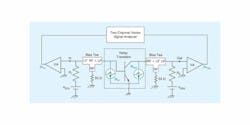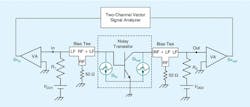Why Measure a Microwave Device at Low Frequencies?
To better understand the nonlinear circuit characteristics of power amplifiers (PAs) and oscillators, it may be advisable to measure them below their normal microwave frequencies of operation. It may be possible to describe critical characteristics using data from the low-frequency (LF) regime of operation, such as noise, linearity performance with modulated signals, phase stability, and amplitude stability. At the University of Limoges, Rue Jules Valles, France, the practice of taking LF measurements of microwave devices for modeling purposes has been explored by Jean-Christophe Nallatamby, Raphael Sommet, Sylvain Laurent, Michel Prigent, Raymond Quere, and Olivier Jardel.
Their paper describes methods for LF measurements that can accurately define the characteristics of critical oscillator and PA parameters. Examples include oscillator noise, carrier wave (CW), pulsed load-pull characteristics, linearity, and memory effects on PAs. These methods may be able to provide non-invasive ways to relate computer-aided-design (CAD) drafting-model mechanics with device physics. In doing so, they can improve the device-model development chain.
For oscillators, LF spectral components are generally exhibited as small perturbations in the RF spectrum. They have minimal effect on large-signal steady-state performance. Clearly, these components are of low magnitude and thus difficult to detect. To better understand these phenomena, LF noise sources must be accurately measured and modeled.
Modulated signals—either in pulsed or complex modulation modes—are the dominant indicators of the nonlinearities of PA mixing properties. These nonlinearities can affect device bias and even large-signal performance. Thermal and trapping effects also influence the saturation currents and threshold voltages of many transistor types. Characterizing these effects requires a description of the LF parasitics. See “A Microwave Modeling Oxymoron? Low-Frequency Measurements for Microwave Device Modeling,” IEEE Microwave Magazine, June 2014, p. 92-107.
About the Author
Jean-Jacques DeLisle
Jean-Jacques graduated from the Rochester Institute of Technology, where he completed his Master of Science in Electrical Engineering. In his studies, Jean-Jacques focused on Control Systems Design, Mixed-Signal IC Design, and RF Design. His research focus was in smart-sensor platform design for RF connector applications for the telecommunications industry. During his research, Jean-Jacques developed a passion for the field of RF/microwaves and expanded his knowledge by doing R&D for the telecommunications industry.

